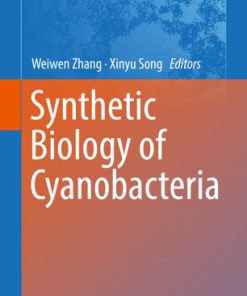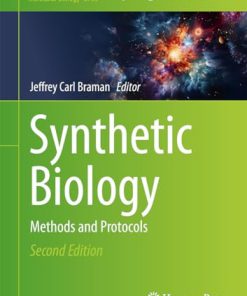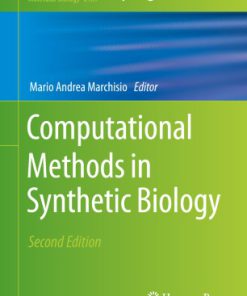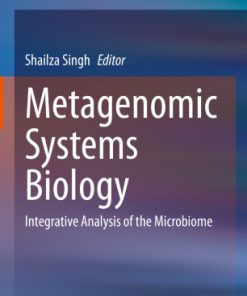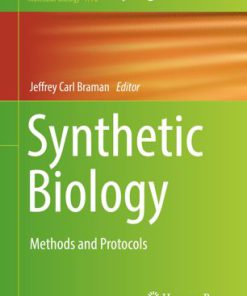Systems Biology Application in Synthetic Biology 1st Edition by Shailza Singh ISBN 8132228073 9788132228097
$50.00 Original price was: $50.00.$25.00Current price is: $25.00.
Systems Biology Application in Synthetic Biology 1st Edition by Shailza Singh – Ebook PDF Instant Download/Delivery: 8132228073, 9788132228097
Full download Systems Biology Application in Synthetic Biology 1st Edition after payment
Product details:
ISBN 10: 8132228073
ISBN 13: 9788132228097
Author: Shailza Singh
This book introduces students to methods that will help them understand behaviour in terms of cellular components and their interactions in non-intuitive ways, which calls for an interdisciplinary approach combining mathematical, chemical, computational and biological strategies. Tibor Ganti was one of the early pioneers who proposed a theoretical framework to understand living principles in terms of chemical transformation cycles and their coupling. The twenty-first century then brought with it a novel ‘systems’ paradigm, which shone new light on all previous work and was accompanied by numerous implications for the way we conceive of chemical and biological complexity today. This book seeks to equip students to take advantage of any field that investigates living systems. Based on a conceptualisation of science-oriented branches, engineering-oriented branches and biology as astoundingly complex fields, those structures laden with biochemical detail encompass a deeper theory unifying our knowledge of designed systems. Readers will be pleasantly surprised at how lucidly the topics are presented. The book offers an indispensable resource for students and professionals working in systems and synthetic biology or any of the various related fields of research.
Systems Biology Application in Synthetic Biology 1st Table of contents:
1: Microbial Chassis Assisting Retrosynthesis
1.1 Introduction
1.2 Tools for Designing and Optimizing Synthetic Pathway
1.3 Choosing a Host and Vector for Synthetic Pathway Construction
1.4 Important Breakthrough in Metabolic Engineering Using Synthetic Biology Approach
1.5 Future Applications
1.6 Challenges and Opportunities
References
2: Computational Proteomics
2.1 Introduction
2.2 Protein Identification
2.2.1 Sequence Database
2.2.2 Taxonomy
2.2.3 Enzyme
2.2.4 Modifications
2.2.5 Peak List File Format
2.2.6 Mass Tolerance
2.2.7 False Discovery Rate (FDR)
2.3 Quantitative Proteomics
2.3.1 Label-Free Quantification Methods
2.3.1.1 Statistical Analysis
2.3.1.2 Visualization and Pathway Analysis
2.3.2 Applications of Quantitative Proteomics
2.4 Interaction Proteomics
2.4.1 Scoring Systems for PPIs
2.4.2 PPI Databases
2.4.3 Applications of Interaction Proteomics
2.5 Metaproteomics
2.6 Proteomics Standard Initiative
2.7 Data Repositories
References
3: Design, Principles, Network Architecture and Their Analysis Strategies as Applied to Biologic
3.1 Introduction
3.2 Biological Networks – Architecture and Design Principle
3.2.1 Metabolic Networks
3.2.2 Transcription Networks or Gene Regulatory Networks
3.2.3 Signal Transduction Networks (STNs)
3.2.4 Protein-Protein Interaction Networks
3.2.5 Protein Domain Networks
3.2.6 Phylogenetic Trees
3.3 Analysis Strategies Applied to Biological Systems
3.3.1 Constraint Based Analysis
3.3.2 Bifurcation Analysis
3.3.3 System Control Analysis
3.4 Conclusion
References
4: Structureomics in Systems-Based Drug Discovery
4.1 Introduction
4.2 Drug Discovery
4.2.1 Investigation of Drug Target and Lead Molecules
4.2.1.1 Target Identification and Validation
4.2.1.2 Hit to Lead Identification
Structure-Guided Drug Discovery
Computer-Aided Drug Design
Fragment-Based Drug Design/Discovery
Scaffold-Based Drug Discovery
De novo Structure Determination of Ligand
4.2.2 Preclinical Research
4.2.3 Clinical Research
4.2.3.1 Phase I Trials
4.2.3.2 Phase II Trials
4.2.3.3 Phase III Trials
4.2.3.4 Phase IV Trials
4.3 Structureomics
4.3.1 Proteins: The Basic Executor of the Cell
4.3.2 Methods in Structural Proteomics
4.3.2.1 Function Basis From Primary Sequence of a Protein
4.3.2.2 Structure Prediction From Sequence
4.3.2.3 Structure Information for Functional Annotation
4.3.2.4 Protein Production
4.3.3 Techniques for Structure Determination
4.3.3.1 X-ray Diffraction
4.3.3.2 Nuclear Magnetic Resonance Spectroscopy (NMR)
4.3.3.3 Cryo-Electron Microscopy
4.3.4 Structural Proteomics Study and Pathway
4.3.5 Structural Genomics Centre and Overview
4.3.6 Advantages of Structural Proteomics
4.3.7 Shortcomings of Structureomics
4.4 Summary
References
5: Biosensors for Metabolic Engineering
5.1 Introduction
5.2 Types of Metabolite Biosensors
5.2.1 Transcription Factor-Based Biosensors
5.2.2 RNA-Based Sensors
5.2.2.1 Transcription-Based RNA Sensors
5.2.2.2 Translation-Based RNA Sensors
5.2.2.3 Stability-Based RNA Sensors
5.2.2.4 Splicing Riboswitch-Based RNA Sensors
5.2.3 Protein Activity-Based Sensors
5.2.3.1 Combined Domain Sensors
5.2.3.2 Intein-Based Protein Sensors
5.2.3.3 Yeast Three-Hybrid Sensors
5.2.4 Whole Cell Sensors
5.3 Applications in Metabolic Engineering
5.3.1 Acyl-CoA Precursor to Fatty Acid Ethyl Ester (FAEE) Production
5.3.2 Malonyl-CoA Precursor to Fatty Acid Production
5.3.3 Mevalonate Precursor to Terpene and Steroid Production
5.3.4 Amino Acid Production
5.3.5 Triacetic Acid Lactone Production
5.3.6 Flavonoid Compounds Production
5.3.7 Biofuel Production
5.3.8 Environmental Toxin Detection
5.4 Methodologies
5.4.1 Design of Transcription Factor
5.4.1.1 Modification of Natural Transcription Factor
5.4.1.2 De Novo Artificial Transcription Factor (ATF)
5.4.2 In Silico Design of Ribozymes
5.4.2.1 Algorithm-Based Design
5.4.2.2 3D Modeling Tertiary Structure- Based Design
5.4.3 Design of Protein Sensor
5.4.3.1 Rational Design
5.4.3.2 De Novo Synthesis of Protein Biosensors
5.4.3.3 Protein Design by Directed Evolution
5.5 Future Perspectives
References
6: Sustainable Assessment on Using Bacterial Platform to Produce High-Added-Value Products from B
6.1 Introduction
6.2 Current Development on Biocatalytic Processes to Produce High-Added-Value Products from Be
6.2.1 Berry Genome Databases Have Been Developed to Identify the Novel Berry Phenolics
6.2.2 Metabolic Engineering on Industrial Host Cell to Produce Berry Phenolics
6.3 Sustainable Assessment Based on Environmental Impacts
6.4 Sustainable Assessment Based on Economic Impacts
6.5 Sustainable Assessment Based on Social Impacts
6.6 Conclusion
References
7: Hindrances to the Efficient and Stable Expression of Transgenes in Plant Synthetic Biology A
7.1 Genome Integration of Foreign DNA
7.1.1 Structure of Transgenic Loci
7.1.2 Positional Effect
7.1.2.1 Targeted Integration
7.1.2.2 Use of Locus Control Regions
7.2 Transgene Sequence Composition
7.3 Promoter and Terminator Usage
7.4 Transgene Transcription
7.5 Strategies to Avoid Transgene Silencing
References
8: The New Massive Data: miRnomics and Its Application to Therapeutics
8.1 Introduction
8.2 miRNA-Based Therapeutic Strategies
8.2.1 miRNA Inhibition
8.2.1.1 Methods for miRNA Inhibition
miRNA Sponges
Anti-miRNA Oligonucleotides (AMO)
Small Molecular Inhibitors of Specific miRNAs (SMIR)
8.2.2 miRNA Replacement Therapy
8.3 Future Prospects
References
9: Microscopy-Based High-Throughput Analysis of Cells Interacting with Nanostructures
9.1 Requirements
9.1.1 Visualizing the Cell
9.1.2 Nanomaterials
9.2 Image Acquisition and Image Resolution
9.3 Image Processing
9.4 Image Segmentation
9.4.1 Thresholding
9.4.2 Watershed Segmentation and Voronoi-Based Approaches
9.4.3 Shape-Based Segmentation
9.5 Feature Extraction and Measurements
9.6 Feature Correlation
9.6.1 Intensity-Based Correlation
9.6.2 Object-Based Correlation
9.7 Object Tracking and Digital Video Analysis
9.8 Conclusion
References
10: Mathematical Chemodescriptors and Biodescriptors: Background and Their Applications in the P
10.1 Introduction
10.2 Mathematical Characterization of Structure: Molecules and Biomolecules
10.2.1 The Molecular Structure Conundrum: Simple Graph to Quantum Chemical Hamiltonians
10.2.2 The Philosophical Basis of Modeling in Mathematical Chemistry
10.2.3 Mathematical Chemodescriptors: Topological Indices, 3D Descriptors, and Quantum Chemical In
10.2.4 Hierarchical Classification of Descriptors
10.3 Quantitative Structure-Activity Relationship (QSAR) Using Chemodescriptors
10.3.1 Statistical Methods for QSAR Model Development and Validation
10.3.2 Intrinsic Dimensionality of Descriptor Spaces: Use of Principal Component Analysis (PCA)
10.3.3 Some Examples of Hierarchical QSAR (HiQSAR) Using Calculated Chemodescriptors
10.3.3.1 Aryl Hydrocarbon (Ah) Receptor Binding Affinity of Dibenzofurans
10.3.3.2 HiQSAR Modeling of a Diverse Set of 508 Chemical Mutagens
10.3.4 Two QSAR Paradigms: Congenericity Principle Versus Diversity Begets Diversity Principle Ana
10.3.5 Applicability Domain of QSAR Models
10.3.6 Practical Applications of QSAR
10.4 Molecular Similarity and Tailored Similarity Methods
10.4.1 Arbitrary or User-Defined Similarity Methods
10.4.1.1 Probing the Utility of Five Different Similarity Spaces
10.4.1.2 Molecular Similarity and Analog Selection
10.4.1.3 The K-Nearest Neighbor (KNN) Approach in Predicting Modes of Action (MOAs) of Industria
10.4.1.4 The Tailored Approach to Developing Similarity Spaces
10.5 Formulation of Biodescriptors from DNA/RNA Sequences and Proteomics Maps: Development and
10.5.1 Mathematical Biodescriptors from DNA/RNA Sequences
10.5.2 Mathematical Proteomics- Based Biodescriptors
10.6 Combined Use of Chemodescriptors and Biodescriptors for Bioactivity Prediction
10.7 Discussion
References
11: Epigenetics Moving Towards Systems Biology
11.1 Introduction
11.2 Mechanisms of Epigenetic
11.2.1 DNA Methylation
11.2.2 DNA Methylation on Molecular Basis
11.2.3 Histone Posttranslational Modifications
11.2.4 Chromatin
11.2.5 Non-Protein Coding RNAs
11.3 Role of Epigenetics
11.3.1 Forming
11.3.2 Growth
11.3.3 Environmental Components
11.3.4 Ignition
11.3.5 Cancer
11.4 Conclusion and Future Perspectives
People also search for Systems Biology Application in Synthetic Biology 1st:
Tags:
Shailza Singh,Systems Biology,Application,Synthetic Biology
You may also like…
Engineering
Biology and other natural sciences - Biology
Biology and other natural sciences
Computational Methods in Synthetic Biology Mario Andrea Marchisio
Biology and other natural sciences
Science (General)
Synthetic biology Volume 2 1st Edition Maxim 1788014057 9781788014052
Biology and other natural sciences - Molecular
Synthetic Biology Omics Tools and Their Applications Shailza Singh
Biology and other natural sciences





